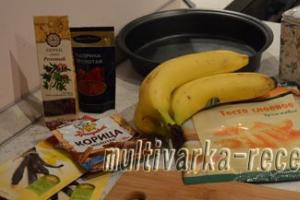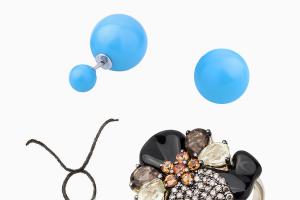A circulation pump in heating systems significantly improves room heating, accelerating the heat transfer process and creating uniform heating in all areas heating system. The main purpose of a circulation pump for a heating system is to create a flow of water through pipelines, preventing overheating of the liquid in the boiler and ensuring accelerated transportation to remote heat exchange devices. Heating pumps are produced by various manufacturers and differ in connection dimensions, electric motor power, performance, and maximum outlet pressure.
Device, components
Circulation pumps for heating systems include a unit housing, an electric motor, and an impeller.
In the majority modern models the device body is attached to the engine. The impeller is placed on the motor shaft. Using this scheme allows you to minimize the size.
The housing has suction and pressure connections with a threaded or flanged connection. For threaded connections, the kit includes union nuts with fittings. With a flange connection, the pump is connected through mating flanges.
On the electric motor there is a cable connection box and a rotation speed switch. Speed control allows you to select the most favorable heating mode for your home while saving energy.
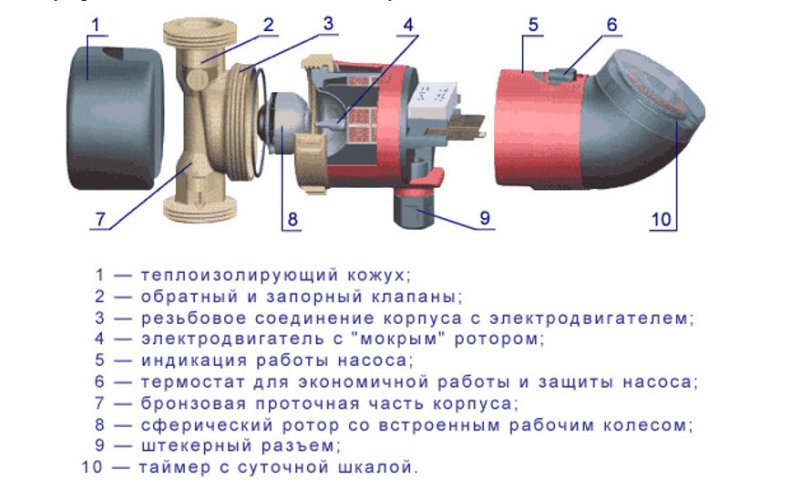
Depending on the design of the electric motor, heating pumps are divided into 2 groups:
- water cooling of the electric motor;
- air cooling of the unit with an impeller.
Circulation pump For heating, the water-cooled motor has insulated windings. Water circulates in the gaps between the rotor and windings. In the center back cover The electric motor has a special hole for removing air. This design ensures virtually silent operation.
A water pump for air-cooled heating contains special sealing collars on the electric motor shaft and gaskets between the housings to prevent water from entering live parts. The noise level of units of this type is higher. Recommended for use in production premises and boiler rooms located separately from residential premises. The selection of a circulation pump for heating should be carried out according to certain parameters.
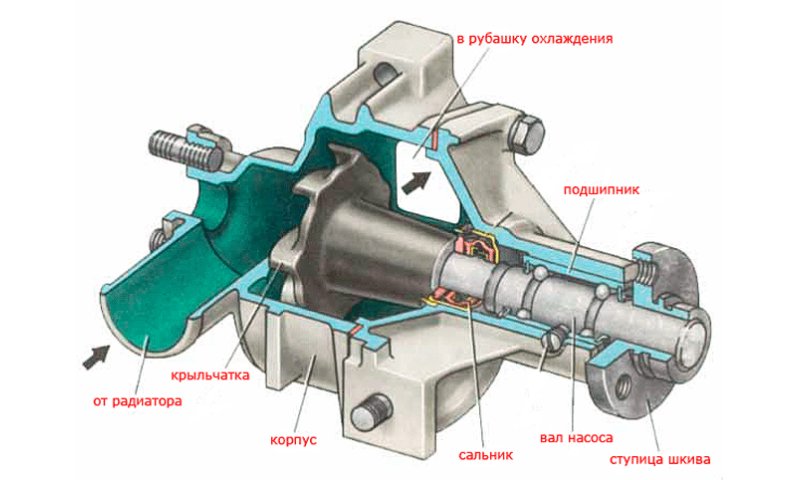
Criterias of choice
Selecting a circulation pump for the system begins with determining the heat consumed by the room. To calculate, use the standard value - heating 10m2 requires 1kW. For example, take a house with an area of 150 m2, the amount of heat will be 15 kW. Performance calculation:
G = Q / ,
- Q - amount of heat (W);
- 1.16 W*h/kg*C - the value of the specific heat capacity of water;
- T max - maximum temperature;
- T min - minimum temperature.
The temperature difference is 20˚ for heating radiators.
15000/1.16*20 = 646.55 kg/h
Pump capacity is indicated in m 3 /hour.
646.55/971.8 = 0.665m3/h
According to the calculation, a heating pump with a flow rate of at least 0.8 m 3 / hour will be required.

The next important parameter is pressure, or pressure. There is a formula for accurately calculating the required pressure, which is used to select a pump. To determine this, you will need passport data for the components of the heating system, calculation of pressure losses at bends and narrowings of the bore diameter. Even experts find it difficult to determine these values correctly. You can select a circulation pump for heating using a simplified expression:
- R - resistance to fluid movement of straight pipes;
- L is the size of the system pipes;
- ZF is a coefficient that takes into account the additional resistance of system components.
How to choose the right correction for a specific system? If ball valves, fittings, connections without narrowing the internal diameter are used, the value is 1.3. If there is a temperature regulator in common pipelines, other restrictions, the coefficient is 1.7. The choice of pump should be made with a margin higher than the calculated value obtained.
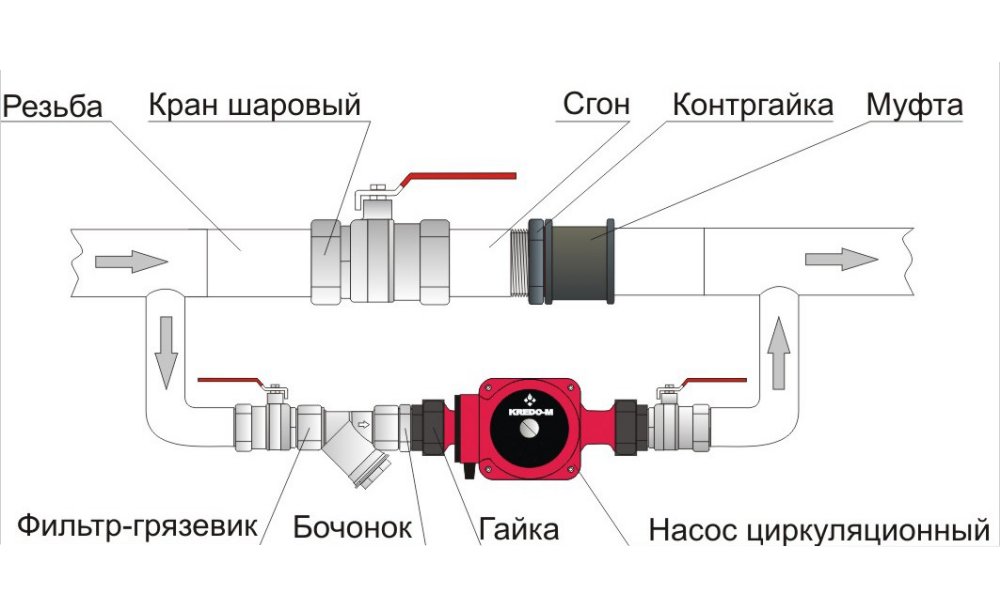
Selection, installation
The calculation of the circulation pump determines the main parameters of the unit. In addition to the calculated values, you should pay attention to the place where you need to install the pump. The dimensions and layout do not make it possible to arrange a separate room of appropriate size for installing a pump in the heating system of a private house. The usual location is in spaces with difficult access, in corners, along walls. Before purchasing, you should review the documentation on how to correctly position the device in spatial position. Many heating pumps have limitations on this point.
Must be taken into account dimensions devices so that the engine and other protruding parts do not rest against the walls.
In the area of the connection points, the heating circulation unit must have free space for grasping the nuts with wrenches, tightening them or loosening them.
Connection to electrical network it is advisable to carry out through a detachable connection such as plug - socket with installation protective devices RCD type and circuit breaker to the maximum permissible current. The supply line must have a grounding conductor. If not, local grounding should be arranged in accordance with the rules of the Electrical Installation Code.
The problem of how to choose a circulation pump is not so difficult. If you have some experience and knowledge, you can solve it yourself. If you are unsure of your capabilities, you should contact a specialist with the question of how to choose a heating pump. Many trading enterprises have competent consultants on staff who help solve most problems. Consultations can be obtained by telephone or by inviting specialists to your home.
Heating systems are capable of operating on natural circulation of liquid. Under these conditions, installation is carried out in such a way that the heated coolant goes into the system, and after energy is released, it returns to the boiler cooled. It will be possible to increase the efficiency of this scheme by installing a circulation hydraulic pump in the circuit.
Based on this, the circulation pump is an important component of the heating and hot water supply system. Due to its use, the working fluid moves with greater intensity along the lines from the heat generator (boiler of any type) to consumers (radiators or underfloor heating systems). Due to the closed circuit and the intensity of the pump, heat transfer increases.
Main settings
A modern circulation pump is a device similar in operating principle to drain pump. In most models, the body is made of the following materials:
- bronze;
- brass;
- cast iron;
- aluminum alloys.
The use of these substances reduces the effect of corrosion on the operation process. The rotating rotor is often made using ceramic materials. On the rotor shaft there is a wheel with blades - an impeller.
The principle of operation of a circulation pump for heating or any other type is that during start-up, due to the rotation of the impeller, an area of reduced pressure is formed near the inlet pipe. Such a vacuum draws in a certain portion of the coolant, and overpressure is pumped at the outlet pipe. This is facilitated by the centrifugal force generated during the rotation of the impeller. Thanks to this compression, fluid moves through closed system heating or hot water supply.
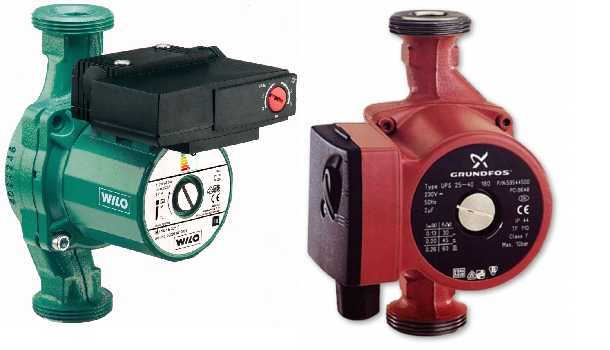
For efficient work hydraulic apparatus requires the following structural elements:
- housing with two inlet and outlet pipes;
- impeller with blades;
- DC electric motor.
Types of devices
To figure out which circulation pump is better, you need to know their types. There are two large groups into which all devices of this type are divided. There are circulation pumps with a wet rotor or a dry one. In each case, they have their own positive and negative properties. Manufacturing companies are constantly working to improve the performance characteristics of models of all types.
Wet rotor units
In devices of this type, the rotor is located in the liquid. The contacts are hidden in a special sleeve made of stainless steel.

During engine operation, additional grinding of the rings is carried out, which only increases the sealing properties of the unit.
This engineering solution uses a coolant in the form of a lubricant. A wet rotor circulation pump can be equipped with one of the following types of electric motors:
- single-phase;
- three-phase.
The power of the electrical appliance is selected accordingly design features apparatus. The inlet and outlet pipes are equipped with threaded or flanged connections, allowing you to quickly and easily install a connection diagram for the circulation pump.
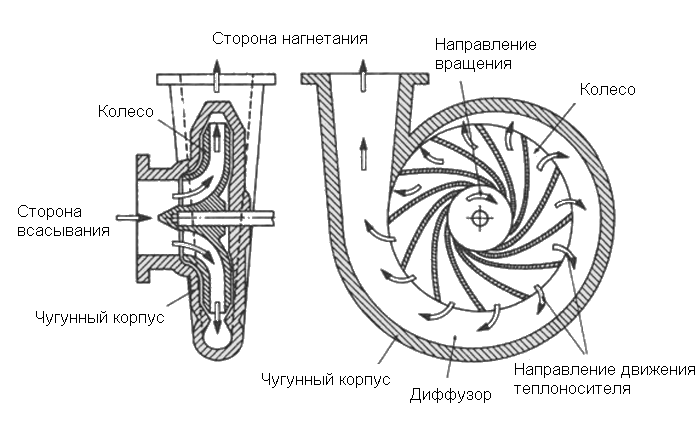
Operating principle of wet rotor equipment
The positive properties of this design are the following:
- small parameters and weight;
- low noise properties;
- minimum voltage consumption;
- long time uninterrupted operation;
- ease of setup and high degree of maintainability.
If the circulation pump in the heating system does not work, this can be easily fixed by replacing the damaged module.
The main disadvantage of a device with a wet rotor is its low efficiency, which does not always reach 50%. This problem is more typical for large-sized devices with large-diameter rotors.
When installing circulation pumps, the rotor shaft must be strictly horizontal. This rule will ensure uniform distribution of water lubricant throughout the sleeve to the rolling bearings.
VIDEO: Installation of a Grundfos circulation pump with a wet rotor
Use of dry rotors
Engineers structurally separated the rotor in pumps of this type with sealing rings made of ceramic or metal with high friction properties. During operation, the rings rotate relative to each other. A thin film of water remains in the narrow gap between the two surfaces of the rings. It helps seal the assembly from the rest of the structure. Due to the pressure difference, the liquid does not flow to the rotor.
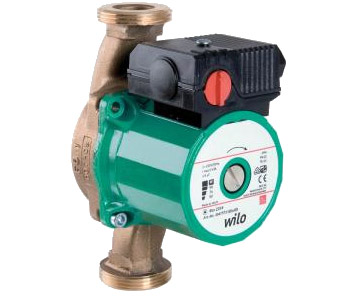
Constant grinding of the rings increases their wear, but a block of springs that regularly press them against each other helps to reduce this factor, minimizing the gaps.
This type of device has a higher efficiency, which reaches 80%. However, the design is not without certain disadvantages:
- wet motor pumps are noisier than their counterparts and therefore often require additional sound insulation;
- special requirements for the purity of the liquid used, since any contamination can disrupt the tightness of the mating rings.
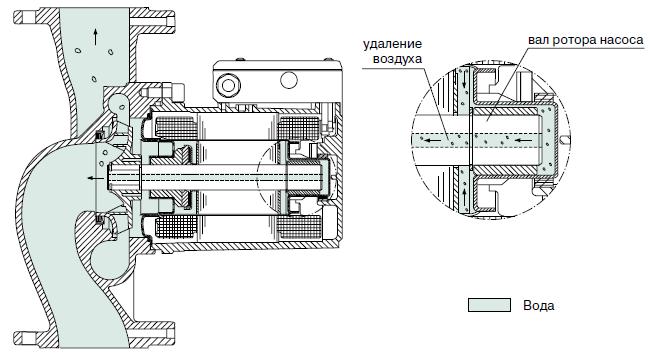
Dry rotor operating diagram
The following types of dry pumps are available:
- vertical, in which the electric motor is mounted vertically and the working pipes are installed in a single axis;
- horizontal, in which the motor is mounted in a horizontal plane, the outlet pipe is installed radially, and the inlet pipe is installed on the end side of the volute;
- block ones, in which the coolant is introduced along the axis and exits in the radial direction.
VIDEO: Disassembly and repair of pressure booster pump Oasis CNP 15/9
Features of installation of circulation pumps
In most cases, installation of this hydraulic equipment carried out by specialists. However, this approach does not prevent you from independently installing the device in a heating or hot water supply circuit. In this case, certain rules must be followed.
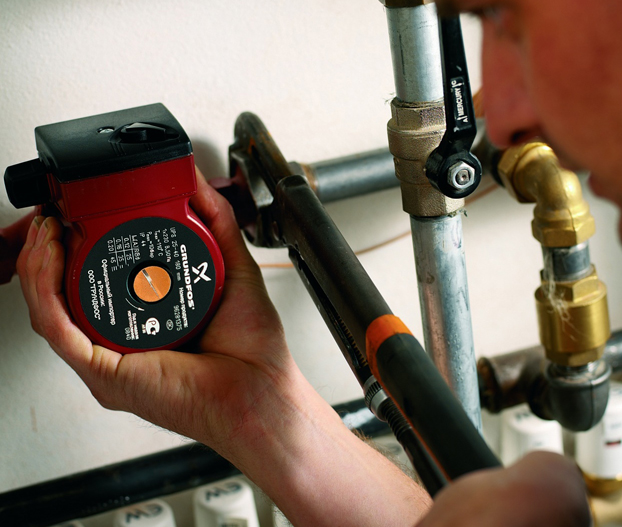
For installation, the least heated area with the coolant is selected - the return line, which returns the cooled liquid to the boiler. For small rooms, area 200 square meters and less, this rule is rather a convention, since the temperature of the liquid at the inlet and outlet differs only by 2-3 0 C.
The flow direction during installation must be observed in the diagram. It is indicated by an arrow on the pump body. Shut-off valves are installed on both sides of the pump, and a coarse filter is installed in front of the inlet pipe. Reliability threaded connections supplemented with sealants. After installing the pump in a horizontal position, coolant is poured into the housing, and excess air is removed using a central screw.
When installing a circulation pump in heating systems using combined circulation, a bypass (pipe with shut-off valves). It will help, if repair or preventative maintenance of the pump is necessary, to circulate the coolant through the system due to the natural circulation of the liquid.
The cost of pumps often depends on their power characteristics. The approximate price is $65-215. The most popular models are products brands Wester, Grundfos, Pedrollo, Halm. Almost all of them have high performance characteristics. Domestic manufacturers household appliances do not produce, but focus on industrial products.
VIDEO: Installation of circulation pump GRUNDFOS into the heating system. Bypass installation
Traditionally, water heating systems were built on the principle of natural circulation of water. In old houses you can see that horizontal pipes go at an angle. The operating principle is the same as in a kettle. Hot water rises, cold water flows down.
The efficiency of such circuits is low due to the high resistance of water in the pipes. If an air plug formed along the route of the coolant, the process could stop altogether. Therefore, to heat the house with gravity systems, pipes were installed large diameter. It was not aesthetically pleasing and expensive.
note
Information: A similar scheme was used only if the boiler was installed directly in the house. With centralized heating, hot water moves along the heating main only with the help of a pump.
For small rooms, such a system is applicable; the coolant will travel a short distance through thin pipes. Therefore, for small country houses use gravity. True, warming up the entire system takes a long time. If you have three or four rooms, especially on different floors, a circulation pump for the boiler is necessary.
Otherwise you will have to wait for the diffusion effect to work. In this case, heat will spread through the pipes at a speed of 10 cm per hour.
What is a heating circulation pump
Essentially it's ordinary water pump blade (turbine) type. There are piston pumps, but they are not used for heating systems.
Inside there is a turbine, which is driven by an electric motor. When rotating, a difference in pressure occurs between the nozzles, and the liquid flows in one direction.
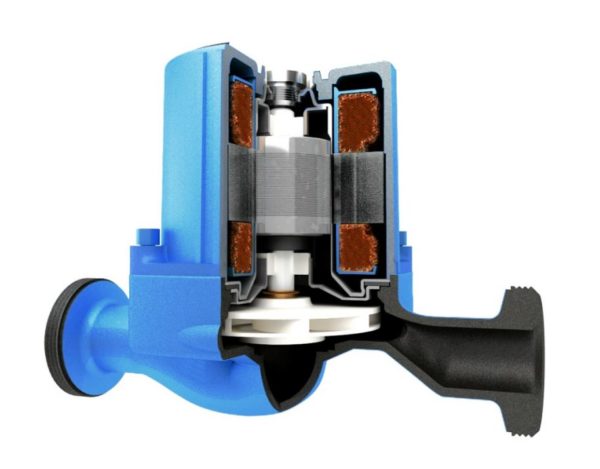
The pump runs at high temperatures coolant, so materials must be heat-resistant and corrosion-resistant:
- aluminum
- bronze
- cast iron
- stainless steel
There are cases made of composite materials - but this is a different price category.
The turbine impeller is made of special polymers. The calculation is for long-term operation; few people would want to regularly disassemble the heating system to replace pump components.
The designs and sizes are very diverse, it will not be a lot of work select a suitable copy. However, the difference is not only in appearance.
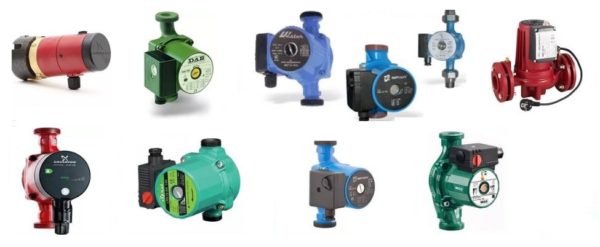
Water pump - differences in design
Bleeding pumps, with all the wealth of choice, are divided into two categories:
Dry rotor
A characteristic difference is immediately noticeable - the engine is clearly separated from the pumping chamber.
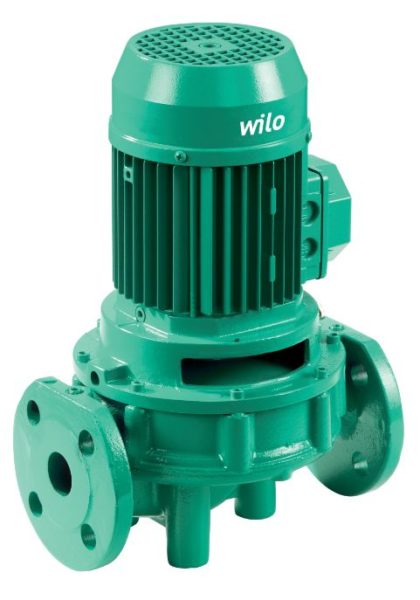
The design provides for the separation of the working turbine and the drive. Only the impeller is in direct contact with water. The motor is located outside, and is connected to the water chamber by a long shaft. Sealing is ensured by seals - like those installed on ship propeller shafts.
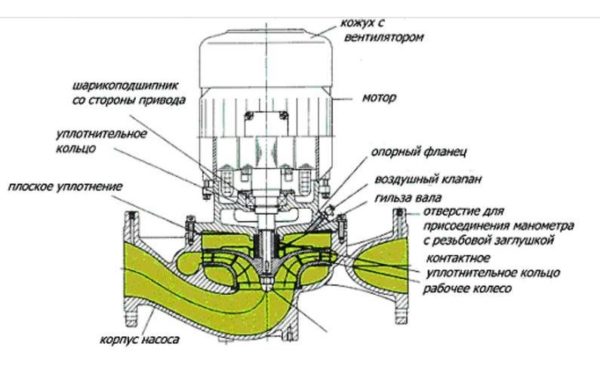
The advantages of the system are high efficiency. IN best models reaches 80%. If necessary powerful pump for a branched system - it will be right choice. Electricity costs will be lower for pumping a large volume of coolant.
There are also disadvantages, and not a few. Such a pump produces a lot of noise, so it should not be installed in a residential area, only in separate boiler rooms. The engine overheats during continuous operation.
A case radiator is required, increasing the dimensions. The weak spot is the oil seals. Under the influence of hot water and small grains of calcium, the rubber bands become tanned and quickly fail.
Therefore, the dry pump requires maintenance after each heating season. If you miss a leak, water can get into the motor windings. Average service life is 3 seasons.
Wet rotor
The main advantage is compactness and neat appearance.
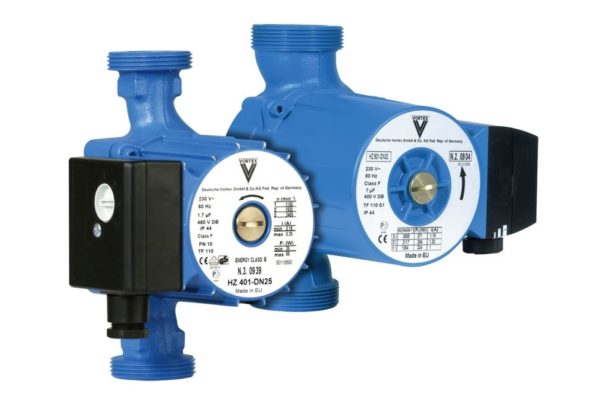
The motor rotor together with the impeller “bathes” in the pumping chamber. This design provides good heat dissipation (despite the temperature of the carrier) and lubrication of the bearings.

note
Note: Those who doubt the lubricating properties of water should remember the design of a car engine water pump.
The electrical part is located in a separate section and is completely protected from moisture.
It works almost silently. This parameter is decisive when choosing a circulation pump for a household. In addition, the pump is maintenance-free. It works on the principle: set it and forget it. Service life 6-8 years. The device is compact, especially in comparison with the previous category.
There is only one drawback - low efficiency. Efficiency rarely reaches 50%. However, for a small cottage or apartment, the pump power is quite sufficient.
How to choose a circulation pump
Appearance and size can hardly be the determining criterion. Boiler equipment is not installed in the front living room, but the circulation pump can be installed in almost any part of the heating circuit.

The main parameters that interest the buyer
Performance
For ease of calculation, it is linearly related to the boiler power. Each kilowatt must be provided with pumping 1 liter per minute. That is, if the power of your boiler is 50 kW, select a pump capacity of at least 50 l/min.
If the weather in your region is unstable, that is, warming may suddenly occur in winter, or April frosts may set in, the recirculation pump must have a speed regulator. The faster the coolant moves through the pipes, the higher the heat transfer. The boiler performance does not need to be changed.
Water pressure
The calculation of the circulation pump depends on the number of floors of the house. To circulate water at one level, regardless of the length of the heating system, 1.5-2 atmospheres is sufficient. Each subsequent floor doubles the value. That is, for a typical two-story cottage with a warm attic, the retaining pressure must be at least 4 atmospheres.
Temperature
The technical characteristics of a heating pump imply working with hot coolant (at least from the point of view of common sense). However, water temperatures vary, and pump manufacturers skimp on materials.
Therefore we need to look at maximum temperature, which guarantees uninterrupted operation. After purchasing a pump, stick to the heating mode. The temperature at the boiler outlet should be 10% lower than the maximum for the pump.
Circulation pump - installation diagram
You can’t just stick a turbine into a pipe cut and turn on the power. To install a pump, you need to know how your heating system works.
It can be single-pipe, when the radiator pipes are simply diverted from main pipe at some distance. This system is used in low-rise Soviet-built buildings.

With this switching on, little pump power is required; a speed controller is not needed. Suitable for climates with smooth transitions from season to season. The system is inert and economical.
The two-pipe system works differently.
The coolant is supplied to the radiators through one pipe, and after cooling it is discharged through the return pipe. Requires a powerful pump with speed control. The advantage is that the system heats up quickly, but it requires more energy.
How to properly install a circulation pump when choosing an installation location
The main rule is to provide a bypass, that is, a workaround.

Three shut-off valves are required.
Important! Cranes must be designed to hot water. Otherwise, the mechanism will quickly give way, and leaks are guaranteed.
The main task is to provide an emergency bypass of water in the event of a pump failure. In addition, you can run water directly to dismantle the electrical appliance, without draining the coolant from the system.
Installing a circulation pump with your own hands is no more difficult than changing the faucet in the bathroom. The main thing is to prepare the pipes “dry”. Pay attention to the quality of the gaskets. If a leak is discovered after filling the system, you will have to drain all the water and redo the faulty connection.
Another trick is that it is recommended to install the circulation pump horizontally, with the motor facing up. For dry rotor systems, this is mandatory requirement. In this case, if the flange connection leaks, the electrical part of the motor will not flood with water. It is advisable that no other connections are located above the pump.
After reading this material, you will be able to choose the right pump, or supervise a team of installers. At a minimum, the validity of the proposed model.
Video review of circulation pumps will help you make the right choice



